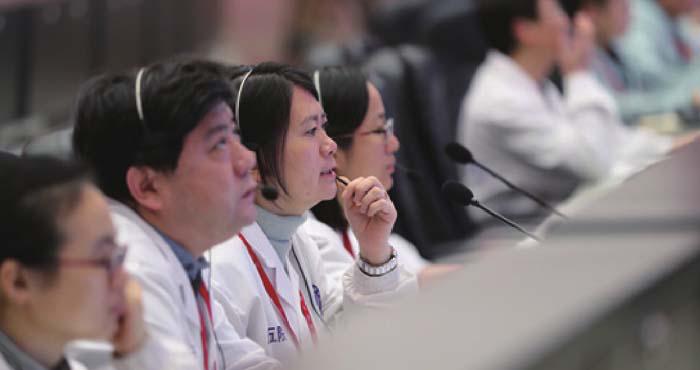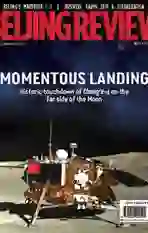A BOLD NEW STEP
2019-02-14ByWangHairong
By Wang Hairong
Tender leaves sprouting from cotton seeds in a container aboard the Change-4 probe to the far side of the Moon add vitality to the otherwise desolate celestial body.
“These are the first biological experiments on the Moon. Scientists have done biological experiments on space stations and other spacecraft before, but never on the Moon,” said Xie Gengxin, chief designer of Change-4s biological experiment payload and Dean of the Institute of Advanced Technology at Chongqing University.
The tests are of great significance for future research and the establishment of a lunar base for human beings, Xie said at a press conference in southwest Chinas Chongqing on January 15.
Fruit fly pupae, yeast, potato seeds, Arabidopsis and rapeseeds were also carried to the Moon to create a mini lunar biosphere, according to Xie. The plants were designed to produce oxygen and food, the fruit flies and yeast to inhale oxygen and exhale carbon dioxide so plants could carry out photosynthesis, while yeast will decompose waste and also serve as food for the fruit flies. The same experiment is being carried out simultaneously on Earth for comparison data, he said.
From January 3, when the experiment was started on the Moon, to January 12, when the container was powered off as the lunar probe went into “hibernation” during the cold lunar night, more than 170 photos as well as soil, temperature and pressure data have been transmitted back to Earth, Xie said, adding that the experiments targets have been reached or exceeded.
During the moons night, the creatures will freeze and then decompose in the sealed container during the next moon day without polluting the environment, Xie added.
Chinas Change-4 lunar probe made the first ever soft-landing by a spacecraft on the far side of the Moon on January 3 after 26 days in space.
After the lander touched down, the rover Yutu-2 inched down the ramp of the lander and made its first imprint on the lunar surface. With its arms stretched out on either side, the rover set out to explore the Moon like a curious toddler embracing a new play- ground.
On January 11, the China National Space Administration (CNSA) announced that the Change-4 lunar probe mission was a success, as indicated by the normal functioning of both the lander and the rover, their photographing of each other and the transmission of images to Earth that produced a panoramic picture of the lunar surface with the help of Queqiao, or Magpie Bridge, a satellite launched in May to relay data transmission between Earth and the far side of the Moon.
Scientists working on the lunar probe project were very excited about its success. While watching the lander touch down on the Moon on a giant screen at the Beijing Aerospace Control Center, Zhang He, Executive Director of the Change-4 probe project, could not hold back her tears of joy. “The moon landing is the most critical stage of the whole mission because the process is rife with risks and challenges,” she said.
Jia Yang, the probes deputy chief designer from the China Academy of Space Technology(CAST), said, “It is a perfect display of human intelligence.”
Upgraded rover
Not long after descending on the pockmarked moon surface, Yutu-2 took a “nap”amid the searing noon temperature of over 100 degrees Celsius to prevent overheat- ing. The rover “woke up” on January 10 and resumed activities, snapping pictures and beaming back data.
Mainly powered by solar energy, Yutu-2 is designed to work during moon days and “hibernate” during cold and dark moon nights. A night or day on the Moon is equivalent to about 14 days on Earth.
Yutu-2 is the second lunar rover launched by China. The first rover Yutu landed on the Moon on December 14, 2013, on board Change-3.
Zhang said that Yutu-2 is smarter because it can enter into a dormant state automatically at the beginning of the Moon night according to light levels; moreover, after “waking up,” it can switch into a stable working mode independently. Compared with its predecessor, Yutu-2 is 2 kg lighter at 137 kg, making it the lightest rover on the Moon, said Jia.
Both rovers have a designed lifespan of three months, can climb over 20-cm-high rocks and travel at a maximum speed of 200 meters per hour. “Yutu-2 is stronger and more capable of coping with difficulties,” said Shen Zhenrong, one of the designers of the rover from CAST.
Collaborative efforts
After declaring the mission a success, Wu Yanhua, Deputy Director of the CNSA, said at a press conference in Beijing on January 14, that Change-4 will survey lunar topography and landforms, explore shallow lunar surface structure, analyze mineral composition and observe space environment.
An experiment on reflective laser ranging technology and another on the lunar biosphere will also be carried out.
To complete its scientific tasks, the probe carries 13 scientific payloads including four developed by scientists from Germany, the Netherlands, Saudi Arabia and Sweden, said Wu.
The CNSA attaches great importance to international cooperation and exchanges in aerospace advancement. China has always upheld the principle of openness and cooperation in developing space programs. To date, the CNSA has signed bilateral agreements with 39 countries and joined 18 space-related international organizations, said CNSAs spokesperson Li Guoping at the press conference.
In April 2015, the CNSA solicited payloads from the international community, and received 20 applications from over 10 countries, with four eventually selected, said Li. Chinese and relevant foreign scientists will form teams to carry out joint research using data obtained from these payloads.
Moreover, the CNSA is willing to share data from the nine scientific payloads independently developed by China with foreign space agencies, research institutes and individuals interested in space exploration, Li said.
The lunar probing mission also involves other international collaborative efforts. Wu said a ground station that China built in Argentina has played an important role in the monitoring and control of the mission; the radioisotope heat source jointly developed by Chinese and Russian scientists will support the probe through the lunar night; and China and the European Space Agency have offered support to each other in deep space probing.
Chinese and U.S. scientists have also actively engaged in cooperation, with the Lunar Reconnaissance Orbiter (LRO) of the U.S. National Aeronautics and Space Administration (NASA) observing Change-4, Wu added.
“NASA told us that it hopes to use the LRO satellite in lunar orbit to observe the lunar dust during Change-4s landing for study. Scientists from both countries com- municated through a videoconference. The U.S. side told us about their satellite, and China informed the U.S. side in a timely manner of the longitude, latitude and the time of the Change-4 landing. Because the LRO was not overhead when Change-4 landed, it could not monitor the lunar dust in real time. Later, when the LRO passed overhead, it monitored the lunar probe and NASA published the photos online,” Wu explained.
The CNSA welcomes the participation of foreign space scientists from all countries in its ensuing lunar and deep-space exploration projects through various means, Wu stated.
China has a three-step plan for its lunar probing program: to send a spacecraft to fly around the Moon in 2007, land on the Moon in 2015 and return with lunar samples in 2020. Around the end of 2019, he said, Change-5 is going to bring lunar samples back to Earth, which will mark the completion of the three-step plan.
Wu disclosed that currently the CNSA is organizing experts to deliberate future plans, and three tasks have been preliminary decided. Change-6 will return with lunar samples collected from the lunar South Pole, while Change-7 will carry out a comprehensive exploration of the lunar South Pole, including surveying its topography and landforms, chemical composition and space environment. Change-8 will continue to probe the Moon and carry out lunar-based experiments, including experiments on the technologies needed to build a lunar scientific and technological research base.
During the upcoming lunar landing mission to the Moons South Pole, Wu said, China will provide the international community with 10 kg of payload-carrying capacity on orbiters and landers.
In addition, the Queqiao relay satellite has a three to five-year lifespan left, he said, thus, the CNSA welcomes foreign scientists to conduct scientific research using the satellite.
Wu didnt give a timetable for Chinas manned Moon mission, saying that it is currently under study, with a decision yet to be made.
“Cooperation is the common aspiration of scientists since the data gathered during lunar or deep-space probing is for unraveling the mysteries of the universe, a common responsibility of all the countries of the world,”Wu said. Countries with strong space programs, in particular, should focus more on cooperation and make more contributions to the exploration of the universe for humanity, he said. n
